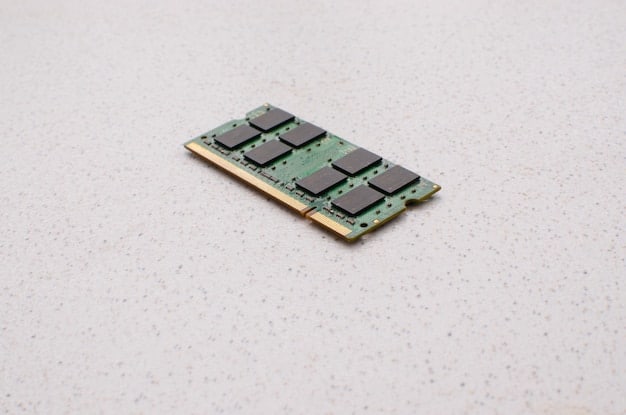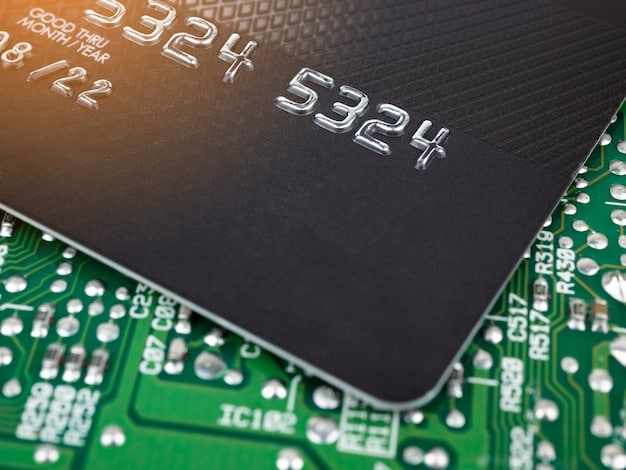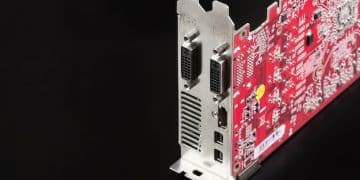Maximize Your Investment: Reselling Your Used NVIDIA RTX 30 Series Card

Maximize resale value of your used NVIDIA RTX 30 Series card by assessing its condition, cleaning it thoroughly, understanding market trends, and exploring various selling platforms, while being transparent about its usage history and overclocking.
Looking to upgrade your gaming rig or simply cash in on your used NVIDIA RTX 30 Series card? Understanding how to maximize resale value of your used NVIDIA RTX 30 Series card in the current market is crucial to getting the best return on your investment.
Understanding the Current Market for Used RTX 30 Series Cards
The market for used graphics cards, particularly the NVIDIA RTX 30 Series, is dynamic and influenced by factors like new GPU releases, cryptocurrency mining trends, and overall supply and demand. Understanding these trends is the first step in maximizing your card’s resale value.
Factors Influencing Resale Value
Several elements dictate the price you can command for your used RTX 30 Series card. New product announcements, especially from NVIDIA and AMD, can shift demand and prices. The rise and fall of cryptocurrency mining can also impact the market, as miners often flood the market with used cards after a mining downturn.
- Monitor current market prices on platforms like eBay,Reverb, and local marketplaces.
- Track announcements of new GPU releases and their potential impact on the used market.
- Stay informed about cryptocurrency mining trends and their correlation with GPU demand.
Assessing Your Card’s Worth
Before listing your card for sale, it’s essential to accurately assess its current worth. Consider factors like the specific model (e.g., RTX 3080, RTX 3070), its condition, and any included accessories. Research similar listings to gauge the prevailing market price.

By understanding the current market dynamics and thoroughly assessing your card’s worth, you’ll be well-positioned to set a competitive and attractive price.
Preparing Your RTX 30 Series Card for Sale
The condition of your RTX 30 Series card significantly impacts its resale value. A well-maintained card will fetch a higher price than one that appears neglected or damaged. Taking the time to properly clean and inspect your card is an investment that can pay off handsomely.
Cleaning the Card Thoroughly
Dust and debris can accumulate on the card’s heatsink and fans, affecting its cooling performance and appearance. Use compressed air to gently remove dust from all components. Avoid using liquids or abrasive cleaners, as these can damage sensitive electronics.
Inspecting for Physical Damage
Carefully examine the card for any signs of physical damage, such as bent pins, cracked components, or damaged connectors. Document any imperfections in your listing, providing complete transparency to potential buyers.
- Use compressed air to remove dust from the heatsink, fans, and PCB.
- Inspect the card for bent pins, broken components, and damaged connectors.
- Photograph any imperfections to document them in your listing.
A clean and well-maintained card not only looks more appealing but also demonstrates that you’ve taken good care of your investment. This instills confidence in potential buyers and increases their willingness to pay a premium.
Choosing the Right Selling Platform
Selecting the best platform to sell your RTX 30 Series card can significantly impact the sale price and overall experience. Each platform has its own advantages and disadvantages, including fees, audience reach, and buyer protection policies.
Online Marketplaces
Platforms like eBay,Reverb, and Facebook Marketplace offer a wide audience reach and established buyer/seller protection programs. However, they also charge fees and may require you to handle shipping and returns.
Local Marketplaces
Local marketplaces like Craigslist and Facebook Marketplace allow you to sell locally, avoiding shipping costs and facilitating face-to-face transactions. However, they may offer less buyer protection and require more caution when meeting potential buyers.
Specialty Forums and Communities
Forums and online communities dedicated to PC hardware and gaming can be a great place to find knowledgeable buyers who appreciate the value of your RTX 30 Series card. These platforms often have stricter rules and a stronger sense of community, fostering a more trustworthy environment.

By carefully evaluating the pros and cons of each platform, you can choose the one that best suits your needs and maximizes your chances of a successful sale.
Crafting an Effective Listing Description
Your listing description is your opportunity to showcase the value of your RTX 30 Series card and convince potential buyers that it’s worth their investment. A well-written description should be informative, accurate, and compelling.
Highlighting Key Features and Specifications
Clearly state the model of the card, its memory capacity, and any other relevant specifications. Highlight any unique features or advantages, such as a factory overclock or custom cooling solution.
Being Transparent About Usage History
Be honest about how you’ve used the card, including its age, gaming hours, and whether it’s been used for mining. Transparency builds trust and can prevent disputes down the line.
- Specify the exact model number, memory capacity, and clock speeds.
- Describe any unique features, such as a custom cooler or factory overclock.
- Be transparent about the card’s age, usage, and any previous overclocking.
Providing High-Quality Photos
Include clear, well-lit photos of the card from multiple angles. Show any imperfections or wear and tear, but also highlight its overall condition. Photos are crucial for establishing trust and helping buyers make informed decisions.
A detailed and accurate listing description, combined with high-quality photos, can significantly increase your chances of attracting serious buyers and achieving a higher sale price.
Setting the Right Price
Pricing your RTX 30 Series card correctly is a delicate balance between maximizing your return and attracting potential buyers. Overpricing can scare away potential buyers, while underpricing can leave money on the table. Research and market knowledge are essential for finding the sweet spot.
Researching Comparable Listings
Before setting your price, research similar listings on various platforms. Pay attention to the prices of cards in comparable condition and with similar features. This will give you a realistic understanding of the current market value.
Considering Depreciation and Demand
Graphics cards depreciate over time, especially with the release of newer models. Consider this depreciation when setting your price, but also factor in the current demand for RTX 30 Series cards. If demand is high, you may be able to command a premium.
Careful research and market analysis will enable you to set a competitive price that attracts buyers while still maximizing your return on investment.
Handling Shipping and Payment Securely
Once you’ve found a buyer, it’s crucial to handle shipping and payment securely to protect yourself from scams and fraud. Following best practices for packaging and payment processing is essential for a smooth and successful transaction.
Packaging the Card Securely
Use a sturdy box and plenty of padding to protect the card from damage during shipping. Wrap the card in anti-static bubble wrap and secure it in the box to prevent it from moving around. Consider insuring the package for its full value.
Using Secure Payment Methods
Avoid accepting payments through unsecured methods like personal checks or money orders. Stick to secure payment platforms like PayPal, which offer buyer and seller protection. Be wary of any requests for unusual payment arrangements.
- Wrap the card in anti-static bubble wrap and secure it in a sturdy box.
- Use a secure payment platform like PayPal, which offers buyer and seller protection.
- Be wary of any requests for unusual payment arrangements or personal information.
By taking these precautions, you can minimize the risk of fraud and ensure a secure and successful transaction.
| Key Point | Brief Description |
|---|---|
| 💰 Market Research | Understand current prices and trends for used RTX 30 Series cards. |
| ✨ Cleaning & Inspection | Clean the card thoroughly and inspect for any physical damage. |
| 📝 Listing Details | Provide an accurate and detailed description with high-quality photos. |
| 📦 Secure Shipping | Package the card securely and use a reliable shipping service with insurance. |
What affects RTX 30 Series prices?
Which selling platform is best for an RTX 30 Series?
What if my RTX 30 Series card has damage?
Should I clean my RTX 30 Series before selling?
What are some additional tips for increasing resale value of my RTX 30 Series card?
Maximizing the resale of value for a used NVIDIA RTX 30 Series card involves thorough cleaning, researching the market, setting a fair price, and using secure shipping.
Market demand and hardware state will greatly impact rates.
Online marketplaces, forums, and local options offer different benefits for easy sales.
Listing the damage along with the graphics card’s specifications will help build trust and avoid issues.
Dusting or cleaning your card to look like new will encourage potential buyers with good rates.
Be transparent about the usage and ensure the card is well-maintained when selling.
Conclusion
By implementing these strategies, you can significantly maximize resale value of your used NVIDIA RTX 30 Series card in the current market, ensuring a profitable and hassle-free transaction. Good luck!





